A Short-Term Load Forecasting Method Considering Multiple Factors Based on VAR and CEEMDAN-CNN-BILSTM
Abstract
1. Introduction
- (1)
- By analyzing the error source of the short-term load forecasting, multiple factors strongly correlated with the short-term load data are selected based on the Spearman correlation coefficient. The vector autoregressive model (VAR) with multivariate input is then derived and improved by using the Levenberg–Marquardt algorithm to estimate the model parameters.
- (2)
- To reduce the randomness and volatility of the short-term load, CEEMDAN and permutation entropy (PE) are combined to decompose and reconstruct the original load data into multiple relatively stationary mode components, which are respectively input into the CNN-BILTSM model for forecasting.
- (3)
- The improved VAR with multivariate input is combined with the CEEMDAN-CNN-BILSTM model, and the sine–cosine and Cauchy mutation sparrow search algorithm (SCSSA) is adopted to optimize the parameters of the combinative model to improve the forecasting accuracy.
2. Load Forecast Considering Multi-Factors Using the VAR Model
2.1. Feature Selection Based on the Spearman Correlation Coefficient
2.2. Improved VAR Model Using the Levenberg–Marquardt Algorithm
3. Load Forecasting Using CNN-BILSTM Based on Data Decomposition and Reconstruction
3.1. Load Sequence Decomposition Using CEEMDAN
3.2. Load Sequence Reconstruction Using PE
3.3. Load Forecast Using the Combined CNN-BILSTM Model
4. Combinative Forecasting Model Based on VAR and CEEMDAN-CNN-BILSTM
4.1. Optimiztion of the Combinative Forecasting Model Using SCSSA
4.2. Evaluation Indicators
5. Numerical Analysis
5.1. Forecasting Analysis of the AVR Model with Multivariate Input
5.2. Forecasting Analysis of the CEEMDAN-CNN-BILSTM Model
5.3. Forecasting Analysis of the Combinative Model
6. Conclusions
- (1)
- Based on the Spearman correlation coefficient, the multiple contributing factors strongly correlated with the short-term load are selected, and the improved VAR model with multi-variable input is derived, which can improve the forecasting accuracy.
- (2)
- In comparison with the single machine learning model, the original load data are decomposed and reconstructed into multiple relatively stationary mode components by combining the CEEMDAN and PE criteria, which can effectively reduce its volatility and randomness and facilitate the CNN-BILSTM model to extract its features. Compared to the EMD, the ERMSE, EMAPE, and EMAE are decreased by 16.81%, 19.44%, and 16.48%, respectively, while the R2 is increased by 0.30%.
- (3)
- The combinative forecasting model based on improved VAR and CEEMDAN- CNN-BILSTM integrates the multivariate time series analysis ability of the mathematical statistics method with the nonlinear fitting advantage of the machine learning method. The proposed method not only considers the impact of multiple contributing factors on the load forecasting but also reduces the volatility and randomness of the short-term load data, effectively improving the accuracy of the short-term load forecasting model.
- (4)
- The error correction is not considered in this paper. A support vector regression model can be introduced in a follow-up study to construct the corrected error sequence and compensate for the initial forecasting sequence so as to further improve the forecasting accuracy.
Author Contributions
Funding
Data Availability Statement
Conflicts of Interest
References
- Rubasinghe, O.; Zhang, X.; Chau, T.K.; Chow, Y.H.; Fernando, T.; Iu, H.H.-C. A novel sequence to sequence data modelling based CNN-LSTM algorithm for three years ahead monthly peak load forecasting. IEEE Trans. Power Syst. 2024, 39, 1932–1947. [Google Scholar] [CrossRef]
- Voumik, L.C.; Islam, M.A.; Ray, S.; Mohamed Yusop, N.Y.; Ridzuan, A.R. CO2 emissions from renewable and non-renewable electricity generation sources in the G7 countries: Static and dynamic panel assessment. Energies 2023, 16, 1044. [Google Scholar] [CrossRef]
- Li, S.; Ye, J. EEOP-based interaction path differentiation and control parameter optimization to mitigate oscillation in multi-DFIG wind farm. IEEE Trans. Power Syst. 2024, 39, 7403–7416. [Google Scholar] [CrossRef]
- Sun, J.; Peng, Y.; Ni, Y.; Wei, w.; Cai, T.; Xi, W. Power load forecasting method based on improved federated learning algorithm. High Volt. Eng. 2024, 50, 3039–3049. [Google Scholar]
- Hua, Q.; Fan, Z.; Mu, W.; Cui, J.; Xing, R.; Liu, H.; Gao, J. A short-term power load forecasting method using CNN-GRU with an attention mechanism. Energies 2025, 18, 106. [Google Scholar]
- Zhou, B.; Zhang, Z.; Li, G.; Yang, D.; Santos, M. Review of key technologies for offshore floating wind power generation. Energies 2023, 16, 710. [Google Scholar] [CrossRef]
- Feng, P.; Xu, J.; Wang, Z.; Li, S.; Shen, Y.; Gui, X. Impact of phase angle jump on a doubly fed induction generator under low-voltage ride-through based on transfer function decomposition. Energies 2024, 17, 4778. [Google Scholar] [CrossRef]
- Wei, N.; Yin, C.; Yin, L.; Tan, J.; Liu, J.; Wang, S.; Qiao, W.; Zeng, F. Short-term load forecasting based on WM algorithm and transfer learning model. Appl. Energy 2024, 353, 122087. [Google Scholar] [CrossRef]
- Hu, W.; Zhang, X.; Li, Z.; Li, Q.; Wang, H. Short-term load forecasting based on an optimized VMD-mRMR-LSTM model. Power Syst. Prot. Control 2022, 50, 88–97. [Google Scholar]
- Xu, J.; Feng, P.; Gong, J.; Jiang, G.; Li, S.; Gui, X. LVRT control strategy of GSC passive sliding mode control for doubly-fed wind turbine. In Proceedings of the 2024 6th International Conference on Energy Systems and Electrical Power (ICESEP), Wuhan, China, 21–23 June 2024; pp. 573–576. [Google Scholar]
- Masood, Z.; Gantassi, R.; Choi, Y. Enhancing short-term electric load forecasting for households using quantile LSTM and clustering-based probabilistic approach. IEEE Access 2024, 12, 77257–77268. [Google Scholar]
- Liu, J.; Cong, L.; Xia, Y.; Pan, G.; Zhao, H.; Han, Z. Short-term power load prediction based on DBO-VMD and an IWOA-BILSTM neural network combination model. Power Syst. Prot. Control 2024, 52, 123–133. [Google Scholar]
- Sias, Q.A.; Gantassi, R.; Choi, Y.; Bae, J.H. Recurrence multilinear regression technique for improving accuracy of energy prediction in power systems. Energies 2024, 17, 5186. [Google Scholar] [CrossRef]
- ElMenshawy, M.S.; Massoud, A.M. Short-term load forecasting in active distribution networks using forgetting factor adaptive extended kalman filter. IEEE Access 2023, 11, 103916–103924. [Google Scholar] [CrossRef]
- Guo, M.; Hao, Y.; Lee, K.Y.; Sun, L. Extended-state Kalman filter-based model predictive control and energy-saving performance analysis of a coal-fired power plant. Energy 2025, 314, 134169. [Google Scholar]
- Xie, Y.; Jin, M.; Zou, Z.; Xu, G.; Feng, D.; Liu, W. Real-time prediction of Docker container resource load based on a hybrid model of ARIMA and triple exponential smoothing. IEEE Trans. Cloud Comput. 2022, 10, 1386–1401. [Google Scholar] [CrossRef]
- Hora, C.; Dan, F.C.; Bendea, G.; Secui, C. Residential short-term load forecasting during atypical consumption behavior. Energies 2022, 15, 291. [Google Scholar] [CrossRef]
- Jeong, D.; Park, C.; Ko, Y.M. Short-term electric load forecasting for buildings using logistic mixture vector autoregressive model with curve registration. Appl. Energy 2021, 282, 116249. [Google Scholar]
- Wang, Z.; Ku, Y.; Liu, J. The power load forecasting model of combined SaDE-ELM and FA-CAWOA-SVM based on CSSA. IEEE Access 2024, 12, 41870–41882. [Google Scholar]
- Wu, J.; Wang, Y.; Tian, Y.; Burrage, K.; Cao, T. Support vector regression with asymmetric loss for optimal electric load forecasting. Energy 2021, 223, 119969. [Google Scholar]
- Shern, S.J.; Sarker, M.T.; Haram, M.H.S.M.; Ramasamy, G.; Thiagarajah, S.P.; Al Farid, F. Artificial intelligence optimization for user prediction and efficient energy distribution in electric vehicle smart charging systems. Energies 2024, 17, 5772. [Google Scholar] [CrossRef]
- Aprillia, H.; Yang, H.-T.; Huang, C.-M. Statistical load forecasting using optimal quantile regression random forest and risk assessment index. IEEE Trans. Smart Grid 2021, 12, 1467–1480. [Google Scholar]
- Zulfiqar, M.; Gamage, K.A.A.; Rasheed, M.B.; Gould, C. Optimised deep learning for time-critical load forecasting using LSTM and modified particle swarm optimisation. Energies 2024, 17, 5524. [Google Scholar] [CrossRef]
- Kong, W.; Dong, Z.; Jia, Y.; Hill, D.J.; Xu, Y.; Zhang, Y. Short-term residential load forecasting based on LSTM recurrent neural network. IEEE Trans. Smart Grid 2019, 10, 841–851. [Google Scholar]
- Wang, F.; Liu, Z. Power load prediction based on IGWO-BILSTM network. Math. Prob. Eng. 2023, 2023, 8996138. [Google Scholar]
- Ouyang, F.; Wang, J.; Zhou, H. Short-term power load forecasting method based on improved hierarchical transfer learning and multi-scale CNN-BILSTM-Attention. Power Syst. Prot. Control 2023, 51, 132–140. [Google Scholar]
- Chen, K.; Chen, K.; Wang, Q.; He, Z.; Hu, J.; He, J. Short-term load forecasting with deep residual networks. IEEE Trans. Smart Grid 2019, 10, 3943–3952. [Google Scholar]
- Shi, Z.; Ran, Q.; Xu, F. Short-term load forecasting based on aggregated secondary decomposition and informer. Power Syst. Technol. 2024, 48, 2574–2583. [Google Scholar]
- Mounir, N.; Ouadi, H.; Jrhilifa, I. Short-term electric load forecasting using an EMD-BI-LSTM approach for smart grid energy management system. Energy Build. 2023, 288, 113022. [Google Scholar]
- Wen, Y.; Pan, S.; Li, X.; Li, Z. Highly fluctuating short-term load forecasting based on improved secondary decomposition and optimized VMD. Sustain. Energy Grids Netw. 2024, 37, 101270. [Google Scholar]
- Hou, R.; Liu, J.; Zhao, J.; Liu, J.; Chen, W. State of charge balancing control strategy for wind power hybrid energy storage based on successive variational mode decomposition and multi-fuzzy control. Energies 2024, 17, 5650. [Google Scholar] [CrossRef]
- Ran, P.; Dong, K.; Liu, X.; Wang, J. Short-term load forecasting based on CEEMDAN and Transformer. Electr. Power Syst. Res. 2023, 214, 108885. [Google Scholar]
- Gopali, S.; Siami-Namini, S.; Abri, F.; Namin, A.S. A comparative multivariate analysis of VAR and deep learning-based models for forecasting volatile time series data. IEEE Access 2024, 12, 155423–155436. [Google Scholar]
- Shang, N.; Lu, Z.; Chen, Z.; Wang, Y.; Wen, F. Empirical analysis of electricity and carbon price correlation based on VARM and copula. Power Syst. Technol. 2023, 47, 2305–2317. [Google Scholar]
- Liu, R.; Li, L. Parameter extraction for energetic hysteresis model based on the hybrid algorithm of simulated annealing and Levenberg-Marquardt. Proc. CSEE 2019, 39, 875–884+966. [Google Scholar]
- Long, Q.; Yu, H.; Xie, F.; Lu, N.; Lubkeman, D. Diesel generator model parameterization for microgrid simulation using hybrid box-constrained Levenberg-Marquardt algorithm. IEEE Trans. Smart Grid 2021, 12, 943–952. [Google Scholar]
- Liu, H.; Li, Z.; Li, C.; Shao, L.; Li, J. Research and application of short-term load forecasting based on CEEMDAN-LSTM modeling. Energy Rep. 2024, 12, 2144–2155. [Google Scholar]
- Hua, H.; Zhu, Y. Short-term Load forecasting based on CEEMDAN PE-GWO-LSTM. In Proceedings of the 2023 3rd International Conference on Energy Engineering and Power Systems (EEPS), Dali, China, 28–30 July 2023; pp. 1096–1101. [Google Scholar]
- Chang, Y.; Yang, Z.; Pan, F.; Tang, Y.; Huang, W. Ultra-short-term wind power prediction based on CEEMDAN-PE-WPD and multi-objective optimization. Power Syst. Technol. 2023, 47, 5015–5026. [Google Scholar]
- Hu, X.; Li, H.; Si, C. Improved composite model using metaheuristic optimization algorithm for short-term power load forecasting. Electr. Power Syst. Res. 2025, 241, 111330. [Google Scholar]
- Li, S.; Tao, D. Optimization to controllability measure of the POD in DFIG-integrated power systems to improve small-signal stability margin considering the impact of pre-fault slip. Electr. Eng. 2024, 106, 5937–5952. [Google Scholar]
- Lv, Q.; Zhang, K.; Wu, X.; Li, Q. Fault diagnosis method of bearings based on SCSSA-VMD-MCKD. Processes 2024, 12, 1484. [Google Scholar] [CrossRef]
- Fan, X.; Li, Y. Short-term power load forecasting based on improved Autoformer model. Electr. Power Autom. Equip. 2024, 44, 171–177. [Google Scholar]
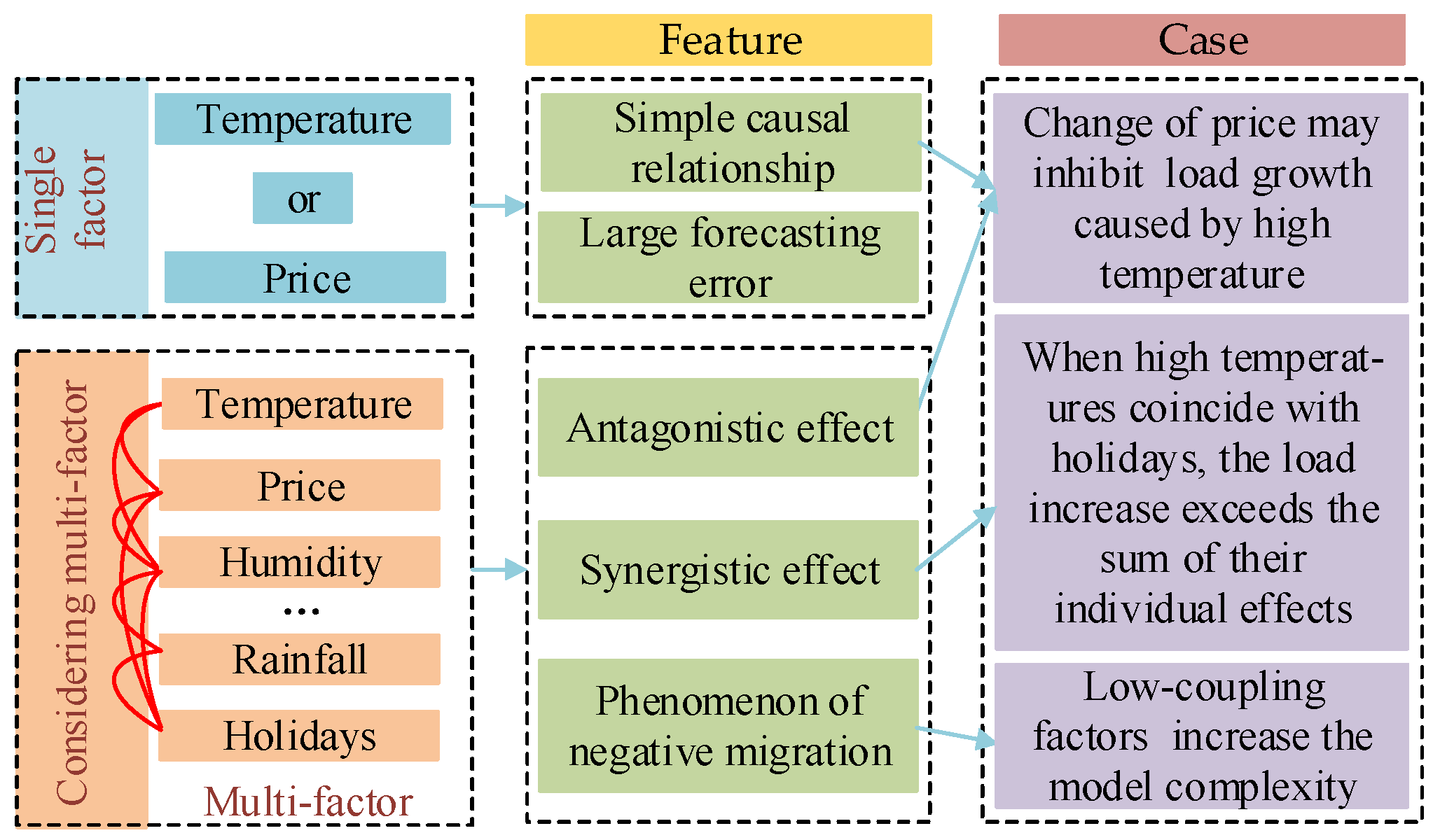
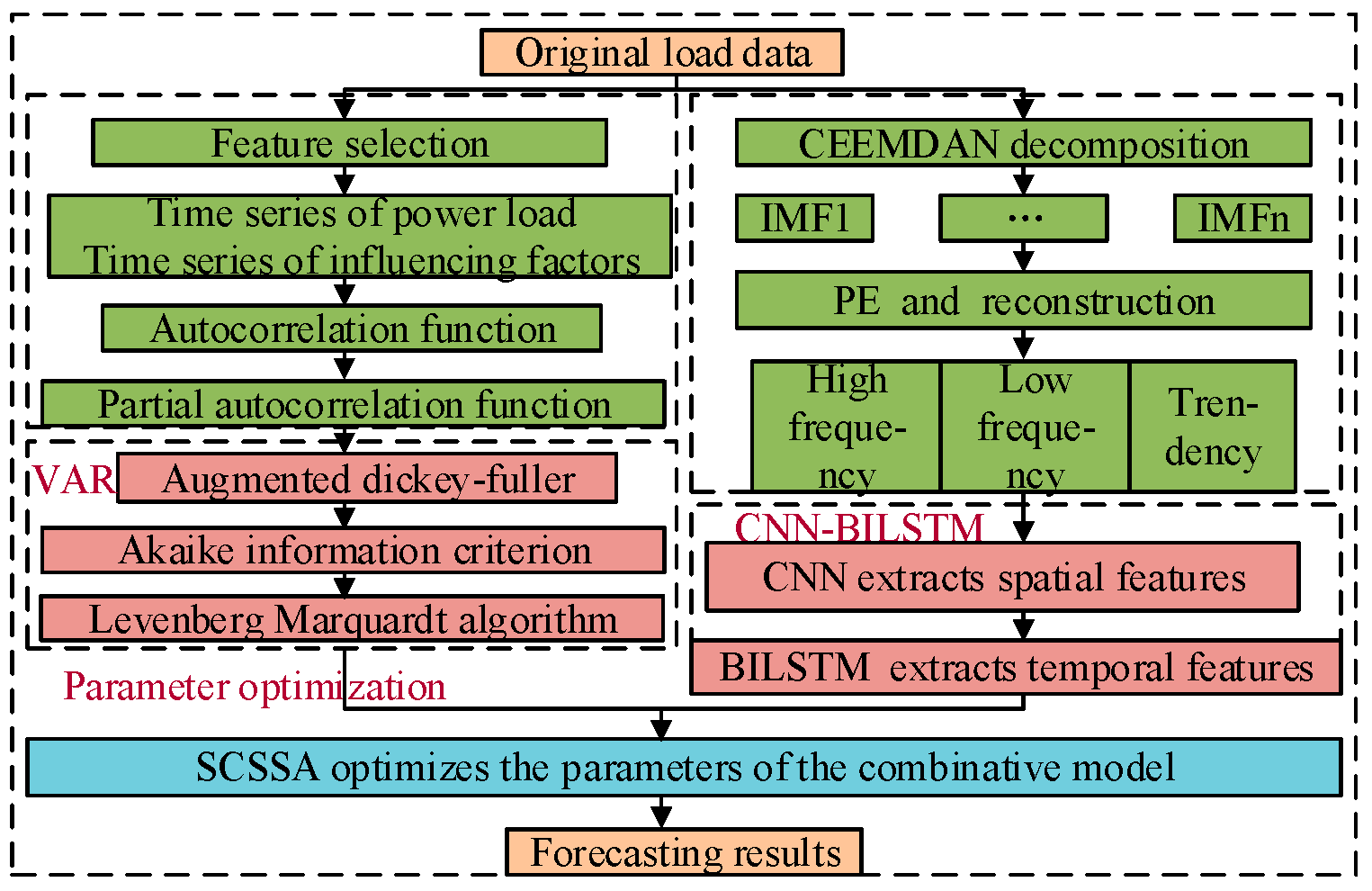

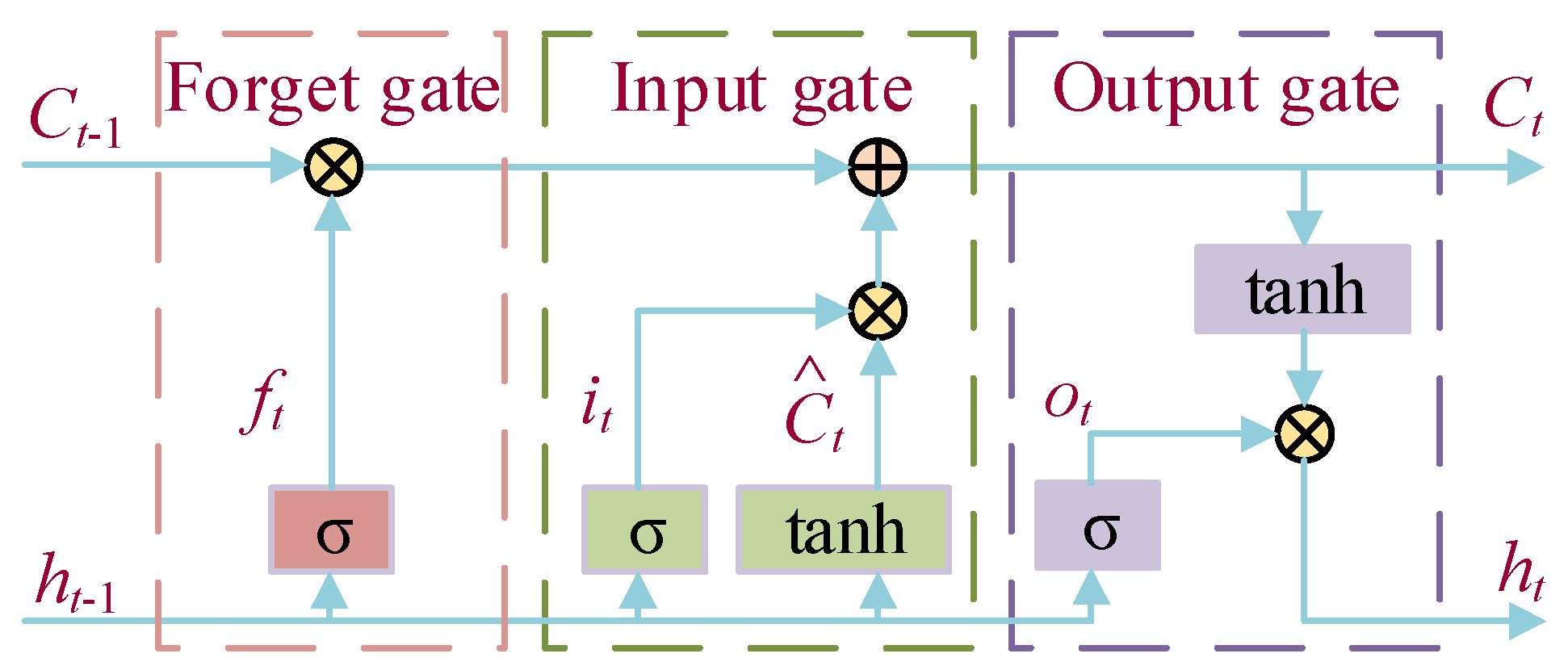
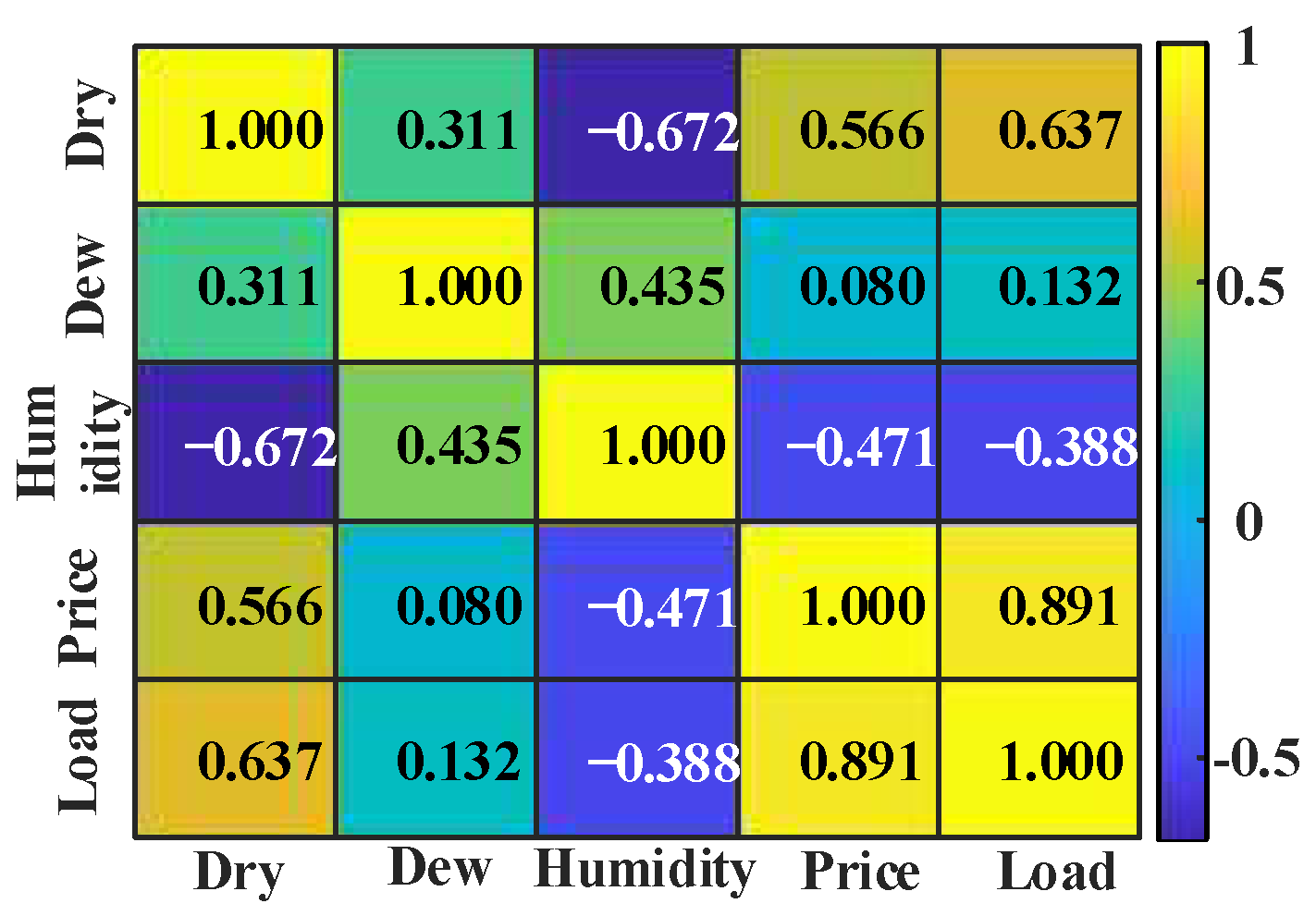
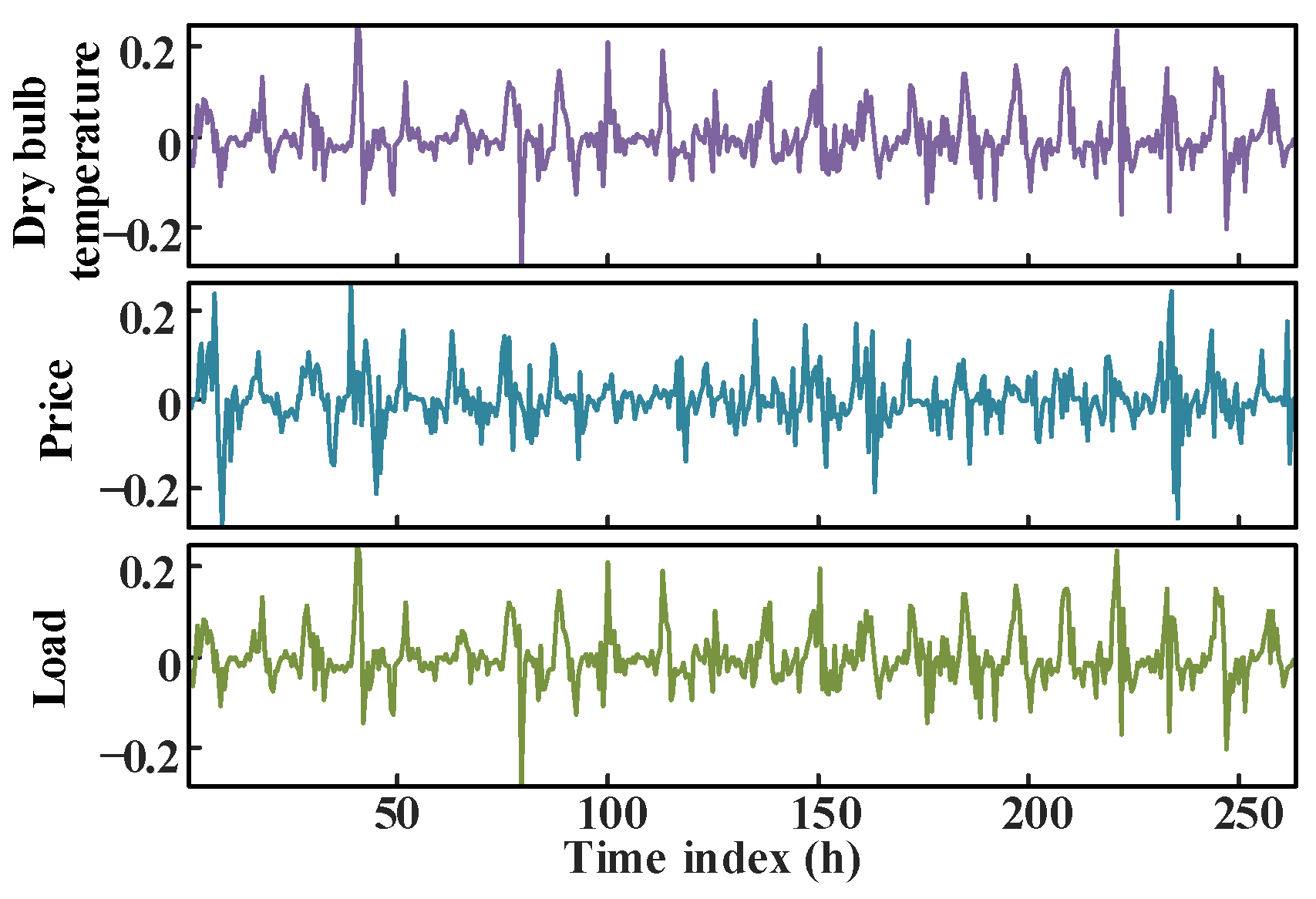
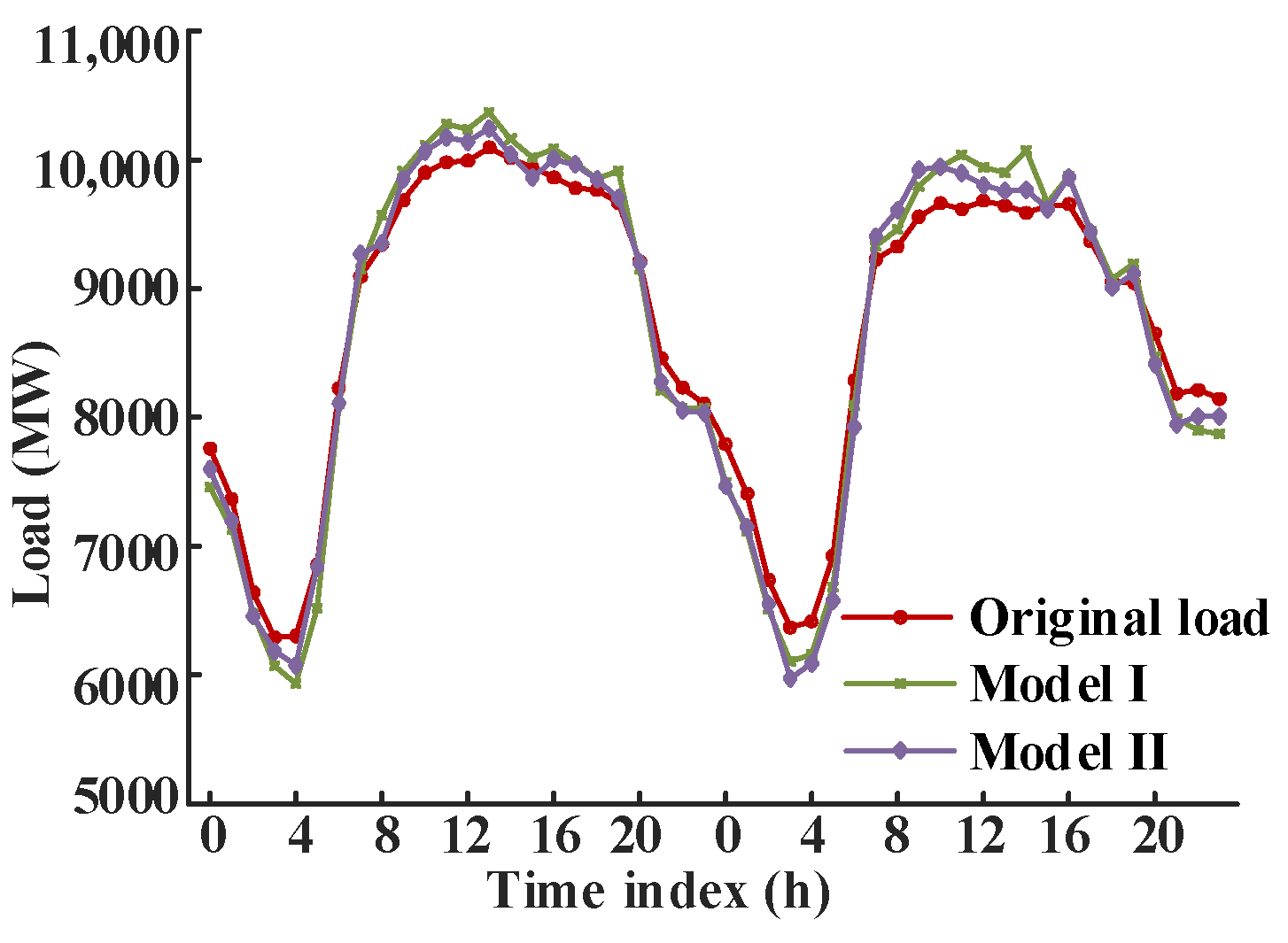

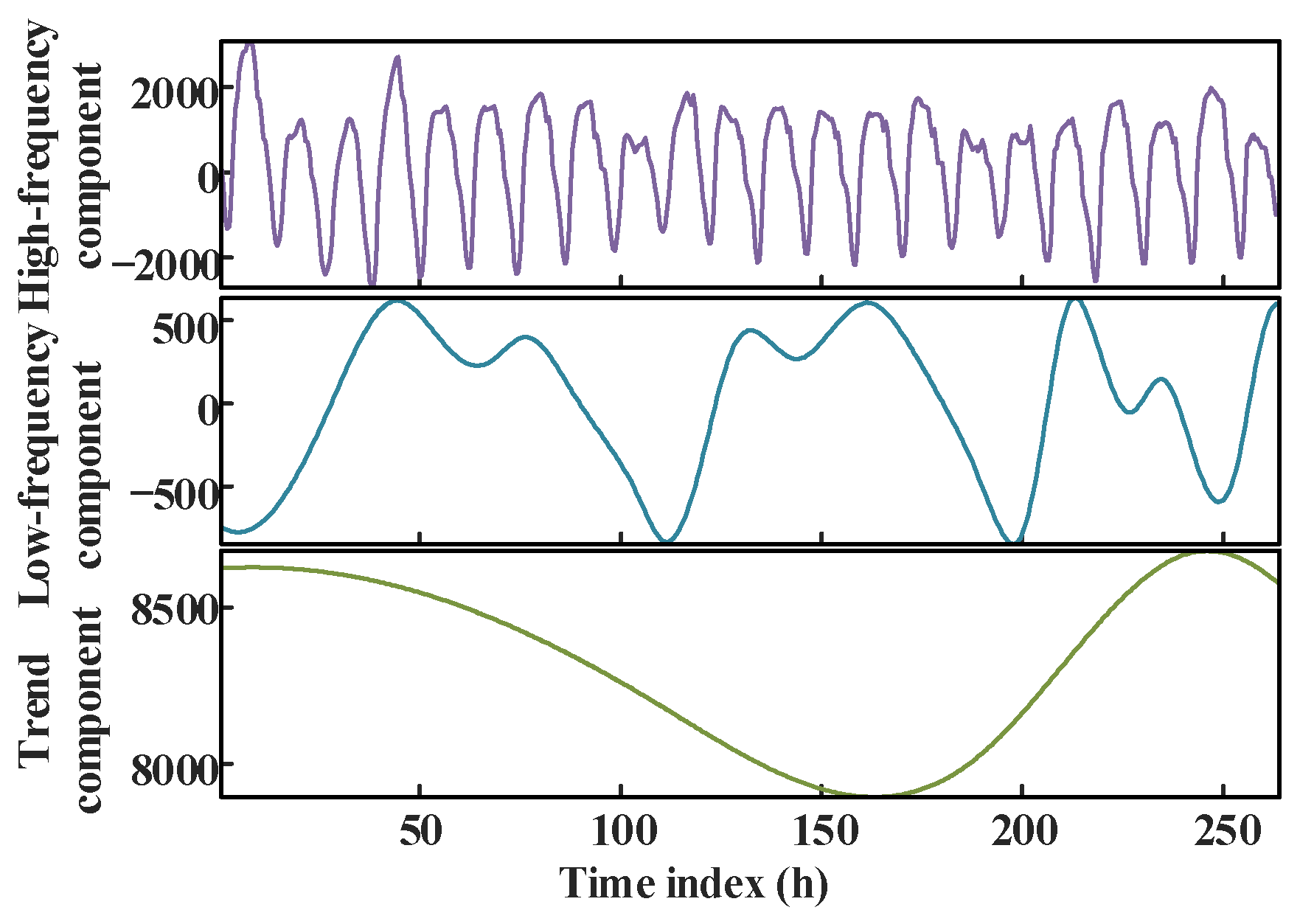
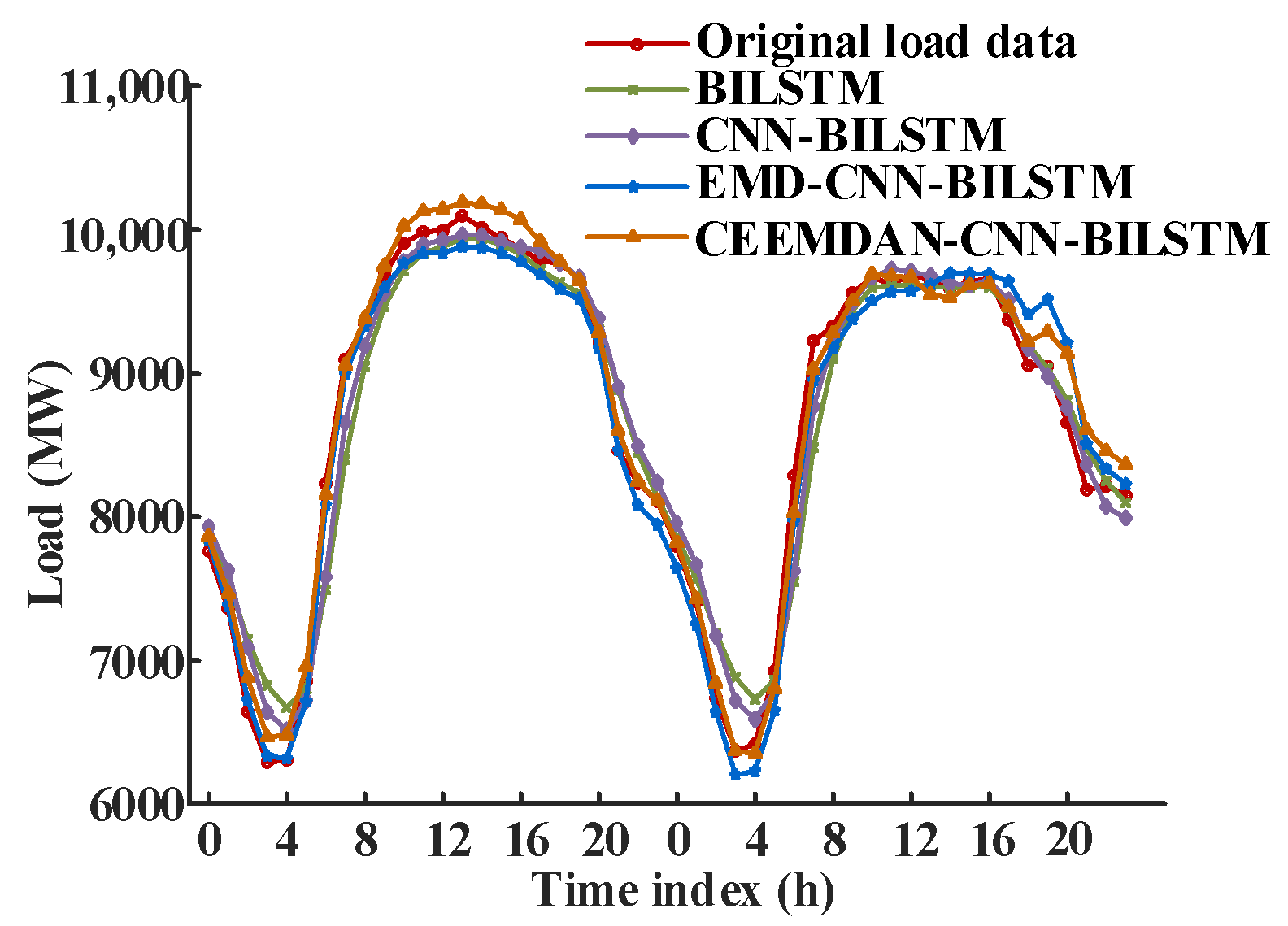
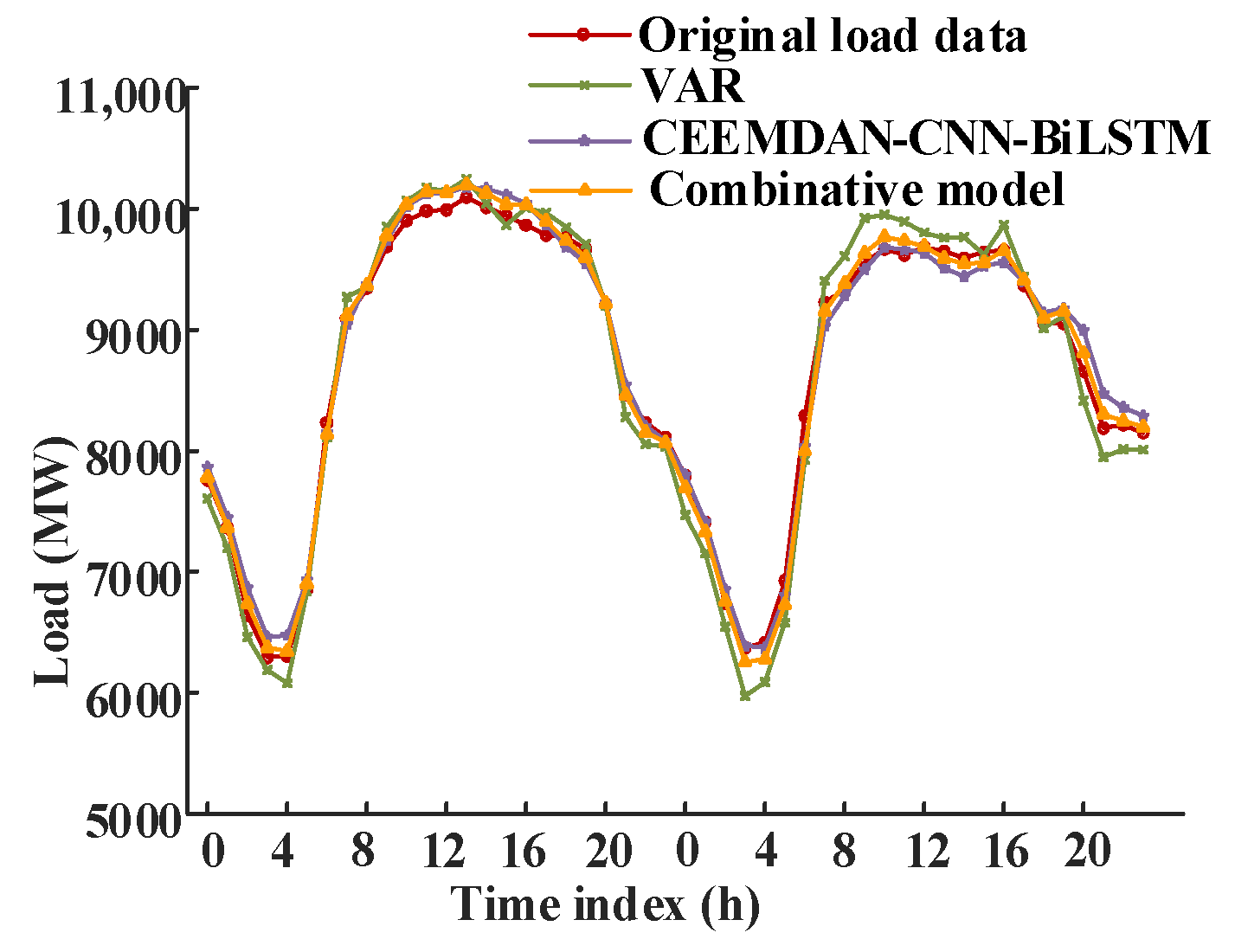
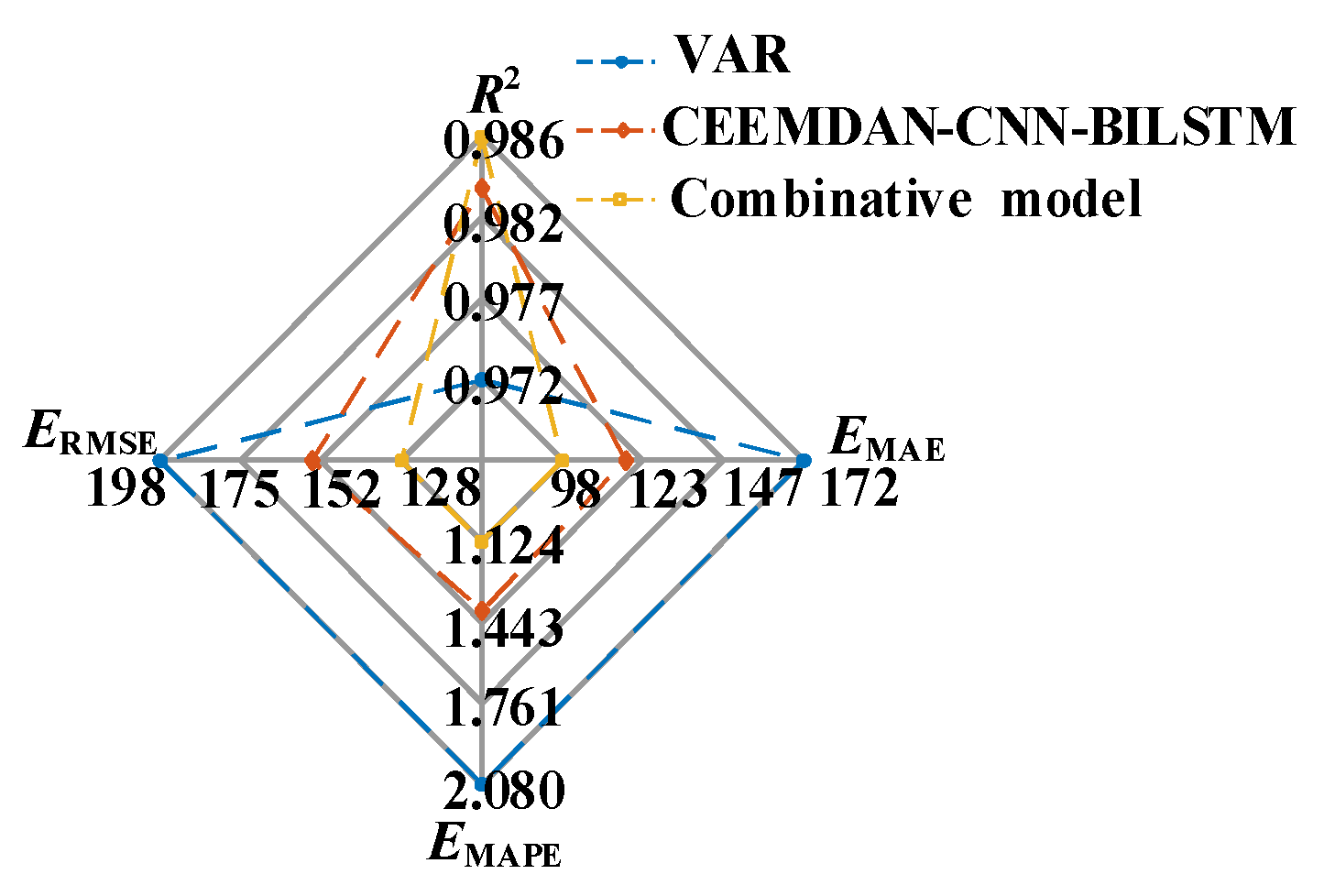
| Reference | Model | Time Scale | Advantage | Limitation |
|---|---|---|---|---|
| [24] | LSTM | 30 min | solve the gradient explosion problem | low data utilization |
| [25] | IGWO-BILSTM | 1 h | bidirectional recursive feedback | weak global search ability |
| [29] | EMD-BILSTM | 1 h | reduce the volatility and randomness of load data | mode mixing |
| [30] | VMD-LSTM | 1 h | solve mode mixing | difficultly parameter selection |
| [32] | CEEMDAN-SE-TR | 1 h | strong adaptability | increased data dimension and calculating work |
| Time Series | ADF Test |
|---|---|
| [Load, Price, Dry bulb temperature] | [0, 0, 0] |
| [Load, Price, Dry bulb temperature] | [1, 1, 1] |
| Forecasting Model | ERMSE (MW) | EMAPE (%) | EMAE (MW) | R2 |
|---|---|---|---|---|
| Model I | 233.979 | 2.537 | 212.208 | 0.96163 |
| Model II | 198.4948 | 2.0801 | 171.6235 | 0.97239 |
| Component | IMF1 | IMF2 | IMF3 | IMF4 | IMF5 |
|---|---|---|---|---|---|
| Entropy value | 0.9963 | 0.9669 | 0.9597 | 0.9647 | 0.7441 |
| reconstruction | High frequency component | Low | |||
| Component | IMF6 | IMF7 | IMF8 | IMF9 | IMF10 |
| Entropy value | 0.7148 | 0.7050 | 0.4961 | 0.4911 | 0.3139 |
| reconstruction | frequency component | Trend component | |||
| Forecasting Model | ERMSE (MW) | EMAPE (%) | EMAE (MW) | R2 |
|---|---|---|---|---|
| BILSTM | 295.3001 | 2.5976 | 208.3223 | 0.93888 |
| CNN-BILSTM | 239.4921 | 2.2267 | 177.0520 | 0.95982 |
| EMD-CNN -BILSTM | 186.8667 | 1.7440 | 149.4268 | 0.97553 |
| CEEMDAN-CNN -BILSTM | 154.2101 | 1.3956 | 117.4744 | 0.98333 |
Disclaimer/Publisher’s Note: The statements, opinions and data contained in all publications are solely those of the individual author(s) and contributor(s) and not of MDPI and/or the editor(s). MDPI and/or the editor(s) disclaim responsibility for any injury to people or property resulting from any ideas, methods, instructions or products referred to in the content. |
© 2025 by the authors. Licensee MDPI, Basel, Switzerland. This article is an open access article distributed under the terms and conditions of the Creative Commons Attribution (CC BY) license (https://creativecommons.org/licenses/by/4.0/).
Share and Cite
Wang, B.; Wang, L.; Ma, Y.; Hou, D.; Sun, W.; Li, S. A Short-Term Load Forecasting Method Considering Multiple Factors Based on VAR and CEEMDAN-CNN-BILSTM. Energies 2025, 18, 1855. https://doi.org/10.3390/en18071855
Wang B, Wang L, Ma Y, Hou D, Sun W, Li S. A Short-Term Load Forecasting Method Considering Multiple Factors Based on VAR and CEEMDAN-CNN-BILSTM. Energies. 2025; 18(7):1855. https://doi.org/10.3390/en18071855
Chicago/Turabian StyleWang, Bao, Li Wang, Yanru Ma, Dengshan Hou, Wenwu Sun, and Shenghu Li. 2025. "A Short-Term Load Forecasting Method Considering Multiple Factors Based on VAR and CEEMDAN-CNN-BILSTM" Energies 18, no. 7: 1855. https://doi.org/10.3390/en18071855
APA StyleWang, B., Wang, L., Ma, Y., Hou, D., Sun, W., & Li, S. (2025). A Short-Term Load Forecasting Method Considering Multiple Factors Based on VAR and CEEMDAN-CNN-BILSTM. Energies, 18(7), 1855. https://doi.org/10.3390/en18071855





